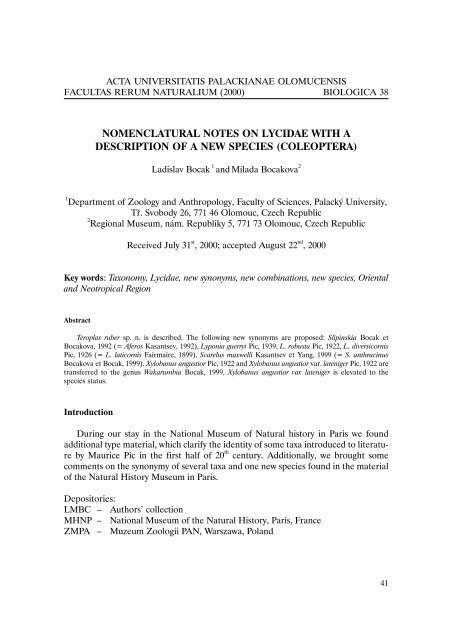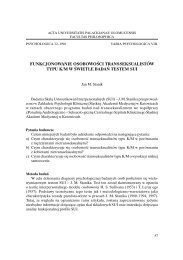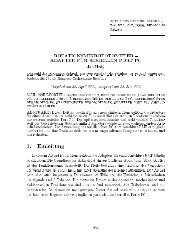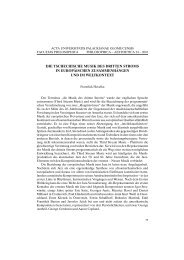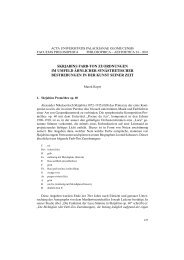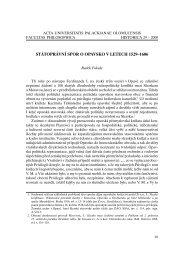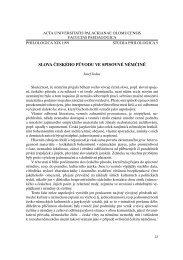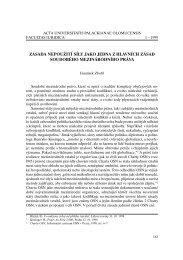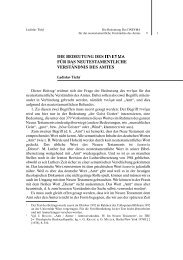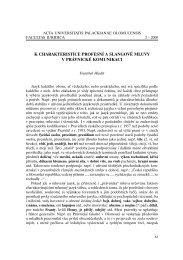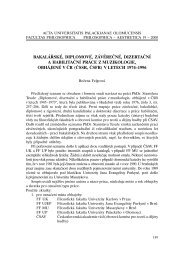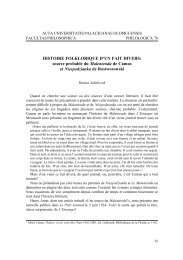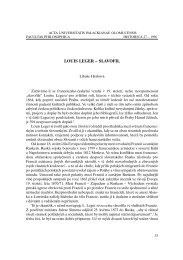nomenclatural notes on lycidae with a description of a new species
nomenclatural notes on lycidae with a description of a new species
nomenclatural notes on lycidae with a description of a new species
Create successful ePaper yourself
Turn your PDF publications into a flip-book with our unique Google optimized e-Paper software.
ACTA UNIVERSITATIS PALACKIANAE OLOMUCENSIS<br />
FACULTAS RERUM NATURALIUM (2000) BIOLOGICA 38<br />
NOMENCLATURAL NOTES ON LYCIDAE WITH A<br />
DESCRIPTION OF A NEW SPECIES (COLEOPTERA)<br />
Ladislav Bocak 1 and Milada Bocakova 2<br />
1 Department <strong>of</strong> Zoology and Anthropology, Faculty <strong>of</strong> Sciences, Palacký University,<br />
Tř. Svobody 26, 771 46 Olomouc, Czech Republic<br />
2 Regi<strong>on</strong>al Museum, nám. Republiky 5, 771 73 Olomouc, Czech Republic<br />
Received July 31 st , 2000; accepted August 22 nd , 2000<br />
Key words: Tax<strong>on</strong>omy, Lycidae, <strong>new</strong> syn<strong>on</strong>yms, <strong>new</strong> combinati<strong>on</strong>s, <strong>new</strong> <strong>species</strong>, Oriental<br />
and Neotropical Regi<strong>on</strong><br />
Abstract<br />
Teroplas ruber sp. n. is described. The following <strong>new</strong> syn<strong>on</strong>yms are proposed: Slipinskia Bocak et<br />
Bocakova, 1992 (= Aferos Kasantsev, 1992), Lyp<strong>on</strong>ia guerryi Pic, 1939, L. robusta Pic, 1922, L. diversicornis<br />
Pic, 1926 (= L. laticornis Fairmaire, 1899), Scarelus maxwelli Kasantsev et Yang, 1999 (= S. anthracinus<br />
Bocakova et Bocak, 1999). Xylobanus angustior Pic, 1922 and Xylobanus angustior var. lateniger Pic, 1922 are<br />
transferred to the genus Wakarumbia Bocak, 1999, Xylobanus angustior var. lateniger is elevated to the<br />
<strong>species</strong> status.<br />
Introducti<strong>on</strong><br />
During our stay in the Nati<strong>on</strong>al Museum <strong>of</strong> Natural history in Paris we found<br />
additi<strong>on</strong>al type material, which clarify the identity <strong>of</strong> some taxa introduced to literature<br />
by Maurice Pic in the first half <strong>of</strong> 20 th century. Additi<strong>on</strong>ally, we brought some<br />
comments <strong>on</strong> the syn<strong>on</strong>ymy <strong>of</strong> several taxa and <strong>on</strong>e <strong>new</strong> <strong>species</strong> found in the material<br />
<strong>of</strong> the Natural History Museum in Paris.<br />
Depositories:<br />
LMBC – Authors’ collecti<strong>on</strong><br />
MHNP – Nati<strong>on</strong>al Museum <strong>of</strong> the Natural History, Paris, France<br />
ZMPA – Muzeum Zoologii PAN, Warszawa, Poland<br />
41
Subfamily Platerodinae<br />
Teroplas Gorham, 1884<br />
Teroplas Gorham, 1884: 243. (Type <strong>species</strong>: Caloclad<strong>on</strong> fusculus Gorham, 1881, by<br />
m<strong>on</strong>otypy).<br />
Remark: This American genus can be easily distinguishable from other Platerodinae<br />
in having l<strong>on</strong>g antennae reaching at least apical quarter <strong>of</strong> elytra in both sexes. Its<br />
male genitalia can be discriminated by l<strong>on</strong>g parameres and two ventrodistal projecti<strong>on</strong>s<br />
<strong>of</strong> phallus. A more detailed descripti<strong>on</strong> was given by Bocakova (in press).<br />
Including the <strong>species</strong> described below Teroplas comprises three <strong>species</strong>.<br />
Teroplas ruber sp. n.<br />
Type material: Holotype, male, “Cubilguitz, Vera Paz, Champi<strong>on</strong>” (MNHN).<br />
Etymology. Named in reference to body colorati<strong>on</strong>.<br />
Diagnosis. Teroplas ruber sp. n. differs from other known Teroplas in having red<br />
body colorati<strong>on</strong>, short phallus, and in paramerae c<strong>on</strong>tiguous dorsally.<br />
Descripti<strong>on</strong>. Body dark brown, <strong>on</strong>ly pr<strong>on</strong>otum red, scutellum and elytra redbrown.<br />
Head <strong>with</strong> large eyes, eye diameter 1.8 times l<strong>on</strong>ger than interocular distance.<br />
Antennae filiform, reaching apical <strong>on</strong>e tenth <strong>of</strong> elytra. Antennomere 1 stout, 2 small,<br />
3 by <strong>on</strong>e-quarter shorter than 4. Maxillary palpi short, terminal palpomere securiform.<br />
Pr<strong>on</strong>otum trapezoidal, transverse, widest at basal margin, anterior margin semicircularly<br />
produced forwards, sides elevated. Posterior angles obliquely produced backwards.<br />
Scutellum obl<strong>on</strong>g, weakly emarginate apically. Elytra el<strong>on</strong>gate, slightly widened<br />
apically, 2.4 times as l<strong>on</strong>g as their width medially. Elytra provided <strong>with</strong> dense brown<br />
pubescence. Each elytr<strong>on</strong> <strong>with</strong> 9 weak costae, reticulate cells irregular, but distinct.<br />
Terminal abdominal sternum el<strong>on</strong>gate. Legs slender, compressed, tibiae straight, their<br />
spurs small, trochanters el<strong>on</strong>gate. Male genitalia <strong>with</strong> phallus as l<strong>on</strong>g as paramerae,<br />
ventrodistal projecti<strong>on</strong>s <strong>of</strong> phallus short. Dorsal margins <strong>of</strong> paramerae mutually<br />
c<strong>on</strong>tiguous. Body length: 6.5 mm, humeral width: 1.7 mm. Female unknown.<br />
Distributi<strong>on</strong>: Central America.<br />
Lyp<strong>on</strong>ia (P<strong>on</strong>yalis) laticornis Fairmaire<br />
P<strong>on</strong>yalis laticornis Fairmaire, 1899: 623.<br />
Lyp<strong>on</strong>ia guerryi Pic, 1939: 165 – syn. n.<br />
Lyp<strong>on</strong>ia robusta Pic, 1922: 13 – syn. n.<br />
Lyp<strong>on</strong>ia diversicornis Pic, 1926: 70 – syn. n.<br />
Material examined: Holotype <strong>of</strong> Lyp<strong>on</strong>ia laticornis, male, “Kuatain, Delot<strong>on</strong>, Chine”<br />
(MHNP); Holotype <strong>of</strong> Lyp<strong>on</strong>ia guerryi, female, “Yunnan-Sen 1911”(MHNP);<br />
Holotype <strong>of</strong> Lyp<strong>on</strong>ia robusta, female, “Pe Yen Tsin, Yunnan” (MHNP); Holotype <strong>of</strong><br />
Lyp<strong>on</strong>ia diversicornis, male, “Yunnan” (MHNP).<br />
The revisi<strong>on</strong> <strong>of</strong> Lyp<strong>on</strong>ia was recently published (Bocak, 1999). Although we visited<br />
several times the Natural History Museum in Paris, we found <strong>on</strong>ly recently the types <strong>of</strong><br />
42
Figs 1–5: Teroplas ruber sp. n.: 1 – head and pr<strong>on</strong>otum, 2 – terminal abdominal segments; 3 – basal<br />
antennomeres; 4 – male genitalia.<br />
43
above given <strong>species</strong> described by Maurice Pic. These <strong>species</strong> were left “incertae sedis”<br />
in the revisi<strong>on</strong> and because <strong>of</strong> poor descripti<strong>on</strong>s they were not even classified to<br />
subgenera. The examinati<strong>on</strong> <strong>of</strong> holotypes revealed that they are junior subjective<br />
syn<strong>on</strong>yms <strong>of</strong> Lyp<strong>on</strong>ia (P<strong>on</strong>yalis) laticornis.<br />
Subfamily Ateliinae<br />
Scarelus anthracinus Bocakova et Bocak<br />
Scarelus anthracinus Bocakova et Bocak, 1999: 108 (published April 1999)<br />
Scarelus maxwelli Kasantsev et Yang, 1999: 245 (received December 29, 1998,<br />
accepted May 28, 1999, exact date <strong>of</strong> publicati<strong>on</strong> not available) – syn. n.<br />
Scarelus pedlenburyi Kasantsev et Yang, 1999: 245 – nomen nudum.<br />
Bocak (1995) misunderstood the identity <strong>of</strong> S. riedeli and S. umbrosus <strong>on</strong> the basis<br />
<strong>of</strong> the study <strong>of</strong> <strong>on</strong>e <strong>of</strong> paratypes <strong>of</strong> S. umbrosus (deposited in ZIW) which is not<br />
c<strong>on</strong>specific <strong>with</strong> holotype. Bocakova and Bocak (1999) clarified the situati<strong>on</strong> and<br />
described S. anthracinus. Later, Kasansev and Yang (1999) made the same correcti<strong>on</strong><br />
and they described <strong>new</strong> <strong>species</strong> S. maxwelli. Their article was published later and the<br />
name S. maxwelli is a junior subjective syn<strong>on</strong>ym <strong>of</strong> S. anthracinus. Although Kasantsev<br />
and Yang (1999) designated the name Scarelus maxwelli as a <strong>new</strong> name, they designated<br />
different specimen as a holotype (specimen collected by Dr. Kasansev in Malaysia<br />
in February 1999). Therefore S. maxwelli can not be either c<strong>on</strong>sidered as a <strong>new</strong><br />
replacement name or the designati<strong>on</strong> <strong>of</strong> the holotype would be invalid (ICZN, 1985,<br />
Art. 72 e; ICZN, 1999, Art. 72.7). We c<strong>on</strong>sider S. maxwelli to be a <strong>new</strong>ly described<br />
<strong>species</strong> and c<strong>on</strong>sequently it is not objective but subjective syn<strong>on</strong>ym. The name Scarelus<br />
pedlenburyi designated as “nomen novum” refers to the same <strong>species</strong> by mistake<br />
(Kasantsev and Yang, 1999). It is c<strong>on</strong>sidered to be an unavailable name here.<br />
Kasantsev and Yang (1999) designated also Scarelus luchti as a nomen novum,<br />
although their intenti<strong>on</strong> to describe a <strong>new</strong> <strong>species</strong> is obvious from the c<strong>on</strong>text. The<br />
remaining nomina nova published by Kasantsev and Yang (1999) c<strong>on</strong>form to the Code<br />
(ICZN, 1985, 1999).<br />
Subfamily Metriorrhynchinae<br />
Wakarumbia angustior (Pic) – comb. n.<br />
Xylobanus angustior Pic, 1922: 16<br />
Material examined: Holotype, male, Nord-Celebes, Toli-Toli, Nov.– Dez. 1895, H.<br />
Fruhstorfer (MHNP).<br />
Wakarumbia lateniger (Pic) – comb. n.<br />
Xylobanus angustior var. lateniger Pic, 1922: 16<br />
Material examined: Holotype, female, S. Celebes, Patutuang Jan. 1896, H. Fruhstorfer<br />
(MHNP).<br />
44
W. lateniger was described as a variety <strong>of</strong> Xylobanus angustior. We found that this<br />
tax<strong>on</strong> is separate <strong>species</strong> and transfer it to Wakarumbia.<br />
Subfamily Erotinae<br />
Aferos Kasantsev<br />
Aferos Kasantsev, 1992: 44 (November 30, 1992)<br />
Type <strong>species</strong>: Stadenus aethiops Kleine, 1992<br />
Slipinskia Bocak and Bocakova, 1992: 257 (December 31, 1992)<br />
Type <strong>species</strong>: Stadenus aethiops Kleine, 1992<br />
The descripti<strong>on</strong> <strong>of</strong> Slipinskia was published later and therefore it is a junior<br />
syn<strong>on</strong>ym <strong>of</strong> Aferos. Both genera are based incidentally <strong>on</strong> the same type <strong>species</strong>.<br />
Acknowledgments<br />
We are very grateful to Dr. J. J. Ménier (Paris), Mr. M. Kerley and M. J. D.<br />
Brendell (L<strong>on</strong>d<strong>on</strong>) and Mr. T. Huflejt (Warszawa) who enabled us to study the rich<br />
material deposited in their instituti<strong>on</strong>s. The study was partially supported by a grant<br />
from the Grant Agency <strong>of</strong> the Czech Republic no. 206/98/0539 (L. Bocak) and by<br />
a grant no. RK99P03OMG011 from the Ministry <strong>of</strong> Culture <strong>of</strong> the Czech Republic<br />
(M. Bocakova). The support is gratefully acknowledged.<br />
References<br />
BOCAK, L. (1995): Review <strong>of</strong> the genus Scarelus Waterhouse from Sumatra and Malaysia (Coleoptera:<br />
Lycidae). Stutt. Beitr. Naturk. Ser. A, No 535: 1–10.<br />
BOCAK, L. (1999): A revisi<strong>on</strong> and phylogenetic analysis <strong>of</strong> the genus Lyp<strong>on</strong>ia C. O. Waterhouse, 1878<br />
(Coleoptera, Lycidae). Entomol. Basiliensia 21: 59–103.<br />
BOCAK, L. (2000): Revisi<strong>on</strong> <strong>of</strong> the genus Wakarumbia (Coleoptera: Lycidae). Eur. J. Entomol. 97: 271–278.<br />
BOCAK, L. and BOCAKOVA, M. (1990): Revisi<strong>on</strong> <strong>of</strong> the supergeneric classificati<strong>on</strong> <strong>of</strong> the family Lycidae<br />
(Coleoptera). Pol. Pismo Entomol. 59: 623–676.<br />
BOCAKOVA, M. (in press): Revisi<strong>on</strong> and phylogenetic analysis <strong>of</strong> the subfamily Platerodinae (Coleoptera,<br />
Lycidae). Eur. J. Entomol.<br />
BOCAKOVA, M. and BOCAK, L. (1999): New Lycidae from peninsular Malaysia (Coleoptera). Entomol.<br />
Basiliensia 21: 105–109.<br />
FAIRMAIRE, L. (1899): Descripti<strong>on</strong>s de Coléopteres nouveaux recueillis en Chine par M de Latouche.<br />
Ann. Soc. Ent. Fr. 68: 616–642.<br />
GORHAM, H. S. 1881: Malacodermata. Fam. Lycidae. Biol. Centr. Amer. Col. 3 (2): 1–29.<br />
GORHAM, H. S. 1884: Malacodermata. Suplement. Fam. Lycidae. Biol. Centr. Amer. Col. 3(2): 225–272.<br />
ICZN, 1985: Internati<strong>on</strong>al Code <strong>of</strong> Zoological nomenclature. Third Editi<strong>on</strong>. The Intenati<strong>on</strong>al Trust for<br />
Zoological Nomenclature xx+338 pp. L<strong>on</strong>d<strong>on</strong>.<br />
ICZN, 1999: Internati<strong>on</strong>al Code <strong>of</strong> Zoological Nomenclature. Fourth Editi<strong>on</strong>. The Intenati<strong>on</strong>al Trust for<br />
Zoological Nomenclature xxix+305 pp. L<strong>on</strong>d<strong>on</strong>.<br />
KASANTSEV, S. (1992): Revisi<strong>on</strong> <strong>of</strong> the genus Stadenus (Coleoptera Lycidae) <strong>of</strong> Africa. Russ. Entomol. J.<br />
1(1): 37–50.<br />
45
KASANTSEV, S. and YANG, P. S. (1999): Tax<strong>on</strong>omic and Syn<strong>on</strong>ymic Notes <strong>on</strong> Lycidae (Coleoptera) <strong>with</strong><br />
Descripti<strong>on</strong>s <strong>of</strong> New Species from Taiwan. Chinese J. Entomol. 19: 239–247.<br />
PIC, M. (1922): C<strong>on</strong>tributi<strong>on</strong> a l’étude des Lycides. L’Échange Nr. 407: 16 hors texte.<br />
PIC, M. (1926): Sur le genre Lyp<strong>on</strong>ia Wat. (Col. Lycidae). Bull. bimens. Soc. Linn. Ly<strong>on</strong> 5: 70.<br />
PIC, M. (1939): Malacodermes exotiques. L’Echange 475: 165<br />
46<br />
Acta Univ. Palacki. Olomuc.<br />
Fac. rer. nat. (2000)<br />
Biol. 38, 41–46


